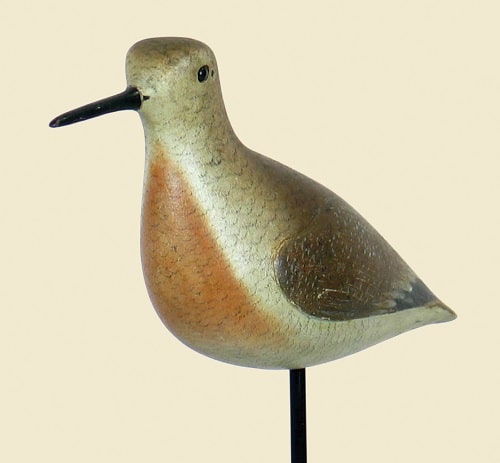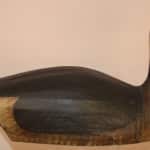By Ted Harmon
The use of decoys to lure waterfowl to the hunter is purely an American invention. Decoys were tools made to lure wildfowl within range of Native Americans and their arrows and later with the waterfowling guns of the early settlers of our great nation. The taking of game of any kind in the Old World was the privilege of the wealthy land owners. Waterfowl hunting in Europe for the most part consisted of trapping and netting wild birds that were lured up narrow creeks or channels by a trained tolling dog that would walk back and forth near the edge of a narrow creek or channel. The pacing of the dog would mesmerize the wild ducks drawing them closer to the dog and the traps. Wild foxes were observed doing this very thing and hunters were quick to train domestic dogs to perform the deadly dance. Hidden nets were placed strategically over the creeks that would spring when released after the fowl reached the “trapping” area. The common folk rarely dared to poach game and if caught they could be shot on sight or subject to arrest and imprisonment. Some of the unlucky were hanged, for “the taking of game on private estates.”
The evolution of hunting with decoys began in the “New World” with Native Americans. Millions of waterfowl migrated in the Atlantic, Mississippi and Pacific flyways in spring and fall. Early on, anything resembling a duck, goose or shorebird would lure birds to the hunter. Native hunters used varied methods. Using already dead birds as a hat, and reeds as a snorkel, Native Americans would walk on the bottom of ponds, lakes and rivers and “catch” birds by pulling them down by their feet from beneath the water. No doubt turtles were observed catching ducks in this way. Stones piled on stones and mud on mud lumps to resemble sleeping ducks were very effective as were shaped reeds with feathers added for wings with color added from soil or clay. Stuffed bird skins or just heads mounted on sticks could be used in areas with tall reeds.
When early settlers came to North America they found an abundance of waterfowl and game birds. They also had an advantage the natives did not. Firearms made the hunting of waterfowl easier than ever before. Settlers were able to provide fresh meat and fowl for the table using the methods borrowed from the Natives and with the use of shotguns. Later, in the 1800s, advances made in “fowling pieces” (shotguns) or rifles allowed many men to hunt for the market or simply feed their families. Hunters often started making wooden decoys for their own use, but found that if they were effective at “decoying” birds other gunners would request decoys be made for them. Skilled wood workers made decoys to be used in the areas they hunted. Whether primitive or academic, wooden bird lures made a huge difference in the success of a “waterfowl” hunt. The lack of prohibitions and a seemingly endless supply of waterfowl fueled the need for quality decoys and a cottage industry was born. Hunting pressure in the late 1800s did decrease the number of birds and increased the need for better tools. Men who had the ability to carve and paint a likeness of the specie they sought to lure often made their own decoys. Less talented hunters turned to local commercial makers such as Anthony Elmer Crowell of East Harwich, Massachusetts on Cape Cod or to factories producing decoys such as the Mason Decoy Company in Detroit, Michigan. Both Crowell, who made decoys by hand, and the Mason Decoy Company began production in the late 1800s. Recently Crowell’s humble little barn and workshop, originally located in East Harwich, was relocated to the grounds of the Harwich Historical Society in Harwich Center on Cape Cod. Crowell made lifelike decoys for hunters starting about 1880 and later, because of a seemingly insatiable demand began carving stunning decorative bird carvings of all species. Other famous decoy makers such as Joseph Lincoln of Accord, Massachusetts, Robert Elliston and Charles Perdew of Illinois, Henry Keyes Chadwick from Martha’s Vineyard and scores of other talented craftsman placed ads in the sporting magazines of the day and decoys were shipped to all areas of North and South America and later to Europe where decoy making has actually evolved for the most part from the American experience.
In the late ’60s and early ’70s decoy values began to increase. American folk art in general became more collectible and sought after. Quality decoys were in the $35 to $75 range, although it was possible at times to find fine examples of decoys from antique shops for as little as $8. Many of the early local collectors in the ’60s felt that decoys made by Anthony Elmer Crowell and Joseph Whiting Lincoln had topped out at $100 to $200 and sold their collections. One of these decoys by Elmer Crowell, similar to one from the collection of the late Carroll Harvey, recently sold for just under $200,000. By the late ’70s good carvings were being sold in the range of $200 to $800. In the ’80s prices moved into the 4 figure area. In the ’90s decoy prices approached 6 figures and later, in the 2000s they reached that lofty level. The recognized record for a duck decoy sold at auction is $801,000. Value depends on rarity, artistic quality, and the condition of the piece. Good decoys do not necessarily have to be by a well-known maker and great decoys still exist that are future classics and are selling for very reasonable amounts.
Whether viewed for their aesthetic beauty or used for their practical applications, there is no doubt that duck decoys are highly appreciated and collectible classics and are selling for very reasonable amounts.
About the Author
Luckily for me, my family moved from a Boston Massachusetts suburb to the small village of Osterville in 1949 on the south shore of Cape Cod. My fascination with wildlife and birds was immediate. Quail, grouse, pheasant, songbirds and waterfowl were abundant. My first duck hunt over hand made wooden decoys was an exhilarating experience. Just to watch wild birds turn to the decoys and land among them was thrilling. Collecting decoys though accidental at first, soon led to a feverish lifelong interest. First as a collector and less than a decade later as a full time dealer. Great decoys were everywhere. In 1986 we held our first auction with an established auction house. A year or two later we launched our own auction firm, Decoys Unlimited Inc. Our last sale on July 26th and 27th was approximately our 60th sale. Please visit our web site to see a copy of our catalog. Our 2015 price key will be published shortly. www.decoysunlimitedinc.net.








Related posts: